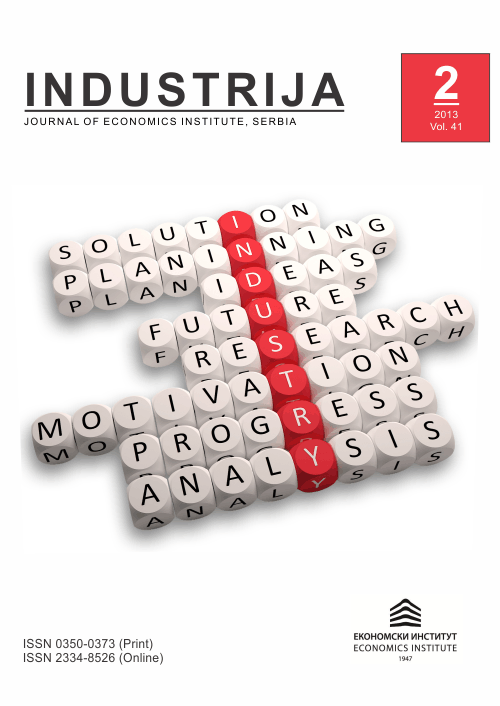Strukturne promene u industriji Srbije u periodu tranzicije
Sažetak
Tranzicija je kompleksan proces u kome se u određenoj zemlji podstiču strukturne promene sa ciljem da se ostvari ekonomski rast i povećanje blagostanja. Cilj istraživanja u ovom radu je da se pokaže da je tokom tranzicije u Srbiji došlo do takvih promena u strukturi, pre svega prerađivačke industrije, koje su rezultovale sa malim privrednim rastom, sporijim nego u drugim zemljama u tranziciji. Primenom teorijskih i empirijskih metoda, deduktivnim zaključivanjem, kao i matematičkim i statističkim pristupom autori su došli do zaključka da se strukturne promene nisu ostvarile u granama kao što je tzv. “Hi-tech” industrija, koje najviše doprinose ubrzanom privrednom rastu. U isto vreme, neke grane industrije koje su nisko-produktivne dobile su na značaju, povećavajući svoje učešće u privredi, što je uticalo da se standard zadrži na relativno niskom nivou. To je uticalo na smanjenje kapaciteta za konvergenciju ka Evropskom proseku kupovne moći, što je postavljeno kao osnovni cilj tranzicije u Srbiji.
Reference
Berg, A. (1994). Does Macroeconomic Reforms Cause Structural Adjustment?, Lessons from Poland. Journal of Comparative Economics, 18, 376-409.
Bošnjak, M. (2011). Rezultati i izazovi ekonomskih reformi u Srbiji u tranzicionom periodu 2001-2008. godine. (p. 56). Belgrade: Ministry of Finance.
Chenery, H.B., & Syrquin, M. (1975). Patterns of Development, 1957–1970. London: Oxford University Press.
-EBRD. (2012). Transition Report 2012 - Integration across borders.
-Eurostat. (2013). Substantial cross-European differences in GDP per capita, Statistics in focus - 47/2012.
Filipović, S., Miljković, M., & Martinović, Đ. (2013). (Un)Competitiveness Of Serbian Industry - The Needs for Reindustrialization. Business Economics, 1, 35-59.
-Government of Republic of Serbia. (2011). Strategy and policy of industrial development of Serbia 2011-2020.
Hansson, A.H. (1995). Macroeconomic Stabilization in the Baltic States ", Stock-holm Institute of East European Economies. Stockholm: Stockholm Institute of East European Economies. working paper.
Jackson, M. (1997). Restructuring or Structural Change in Industry of Transition Countries: A Review of Issues. LICOS Centre for Transition Economics Katholieke Universiteit Leuven. Discussion Paper.
Landesmann, M. (2000). Structural Change in the Transition Economies, 1989 to 1999. Wien: WIIW. working paper.
Ngai, R.L., & Pissarides, C. (2007). Structural change in a multi-sector model of growth. American economic review, 97(1), 429-443.
Repkine, A., & Jackson, M. (1997). A Comparison of Structural Changes among the Branches of Industry in Seven Transition ountries. LICOS Centre for Transition Economics Katholieke Universiteit Leuven. Discussion Paper.
- Statistical Office of the Republic of Serbia. (2013). Online database. Retrieved from http://webrzs.stat.gov.rs/WebSite/public/ReportView.aspx
-USAID. (2010). Postkrizni model privrednog rasta i razvoja Srbije 2011-2020. (p. 370). Belgrade: Economics Institute, Faculty of Economics, USAID.
Zubović, J. (2012). Human capital development as a tool for managing structural changes - secondary education vs. structural changes. In J.S. Andrade, M.C.N. Simoes, & et al. (Eds.), Managing Structural Changes : Trends and Requirements. (pp. 412-426). Coimbra: Faculty of Economics of the University of Coimbra.

